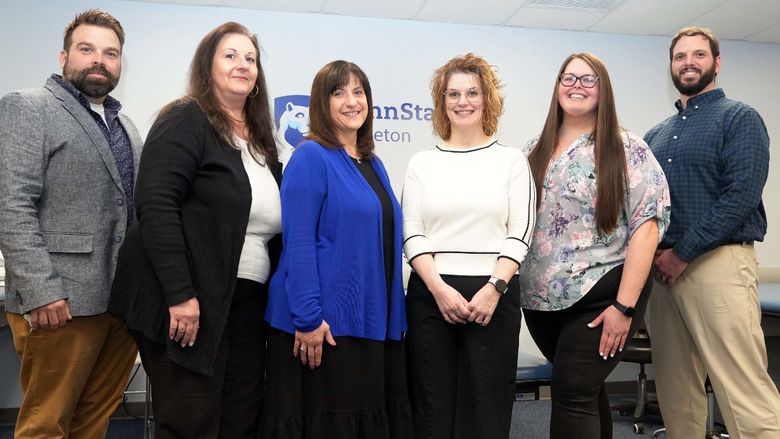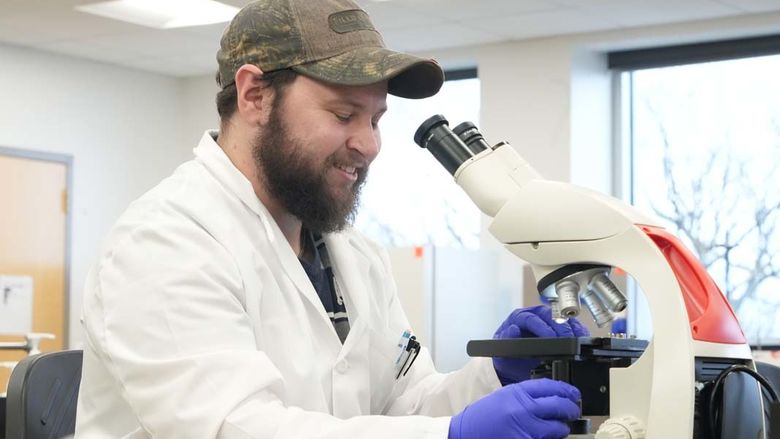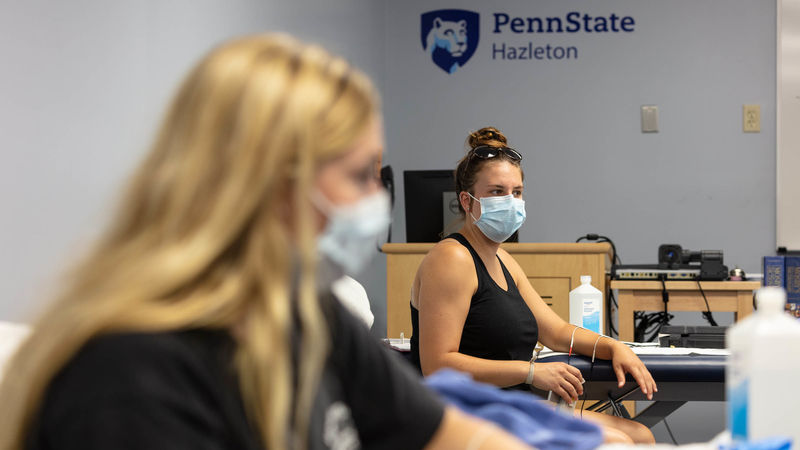

This dialog contains the full navigation menu for this site.

HAZLETON, Pa. – Michael Prebich completed Penn State Hazleton’s physical therapist assistant (PTA) program in 2011 and stayed on to earn a BA degree in 2012 that focused on counseling patients and helping them get through difficult situations.
Now, less than 10 years later, Prebich is vice president for operations at an outfit that works with skilled-nursing facilities and long-term care communities in 37 states. And he gives a lot of credit for his success to Hazleton’s PTA program.
“I’m biased,” he said. “I think it’s the best program out there. It definitely lays a solid foundation clinically to prepare students for their new careers.”
Prebich, along with other program graduates and current students, said Hazleton’s two-year PTA program is rigorous but rewarding. He feels it prepared him well for his current VP position at Remedy Therapy Services, headquartered in Middleburg Heights, Ohio, where he ensures that staffing and clinical needs are being met at some 250 locations across the country.
When students complete the Hazleton program, they are qualified to treat and interact with patients of all ages and in all kinds of situations — from infants, to high school and college athletes, to the elderly — whether they have just come out of surgery, or are recovering from a debilitating illness, or have sustained an injury at work or on the athletic fields. Program graduates have also learned other essential skills, like effective communication and time management.

Rose Petrilla, coordinator of the program and one of its three full-time instructors, emphasized the program’s longevity, the effectiveness it’s gained by going through many accreditation processes, and the resources and support that come from being part of a Big Ten university.
“There’s a push for excellence, and that takes a lot of extra effort,” Petrilla said. “Faculty and staff work very hard to support the students.”
In addition to teaching classes and supervising labs during the day, Petrilla added, faculty and staff “will come into the labs at various times on weekends and evenings to help students learn a skill or use a piece of equipment safely.”
The program has been offered for more than 30 years and has been accredited since 1983 by the Commission on Accreditation in Physical Therapy Education (CAPTE). It combines general education, applied physical therapy sciences, and three full-time clinical learning experiences. Additionally:
After students earn their two-year associate in science degree, they are ready to take and pass a national physical therapy exam to get licensed, which is required to work in the field. (Most do that and go on directly to become employed as a physical therapist assistant.)
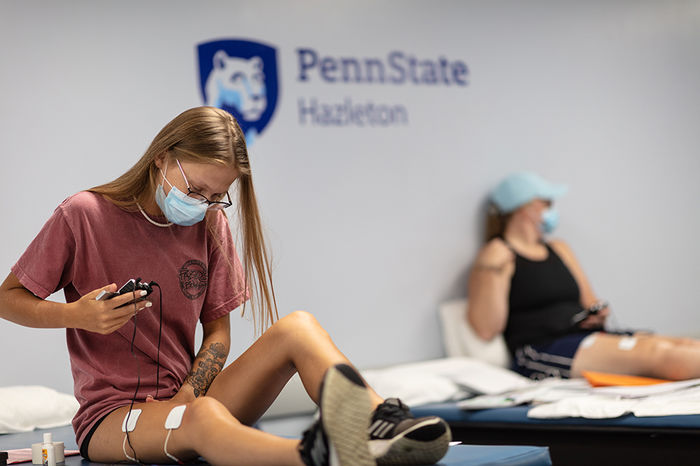
A major employer of Hazleton program graduates and a longtime provider of internships for students in the program is PRO Rehabilitation Services, a privately owned company with 13 locations in five counties. Headquartered in Plains, PRO Rehab Services was founded in 1997 as an outpatient provider of physical, occupational, and aquatic therapy services.
Of the 17 PTAs currently employed by PRO Rehab, 11 are graduates of the two-year Penn State program. “The students from Penn State are very strong clinicians,” said Lynn Distasio, PRO Rehab’s chief operating officer and clinical director. “They really have the background they need to perform the job very well.”
PRO Rehab benefits from hiring program graduates who have done internships there, because they already understand the company’s operations and mission, Distasio said. “The students understand our system. They can step right in and do what needs to be done.”
For the students, Distasio said, the valuable piece of an internship is “the opportunity to work side by side with experienced physical therapists. They get to see how an out-patient private practice operates, what’s necessary for great patient care. Everything we do has to focus on the patient, even documentation.”
Adam Specht, an adult learner in the Hazleton program, has both a BA and a master’s degree in exercise physiology. So, he has a lot of schooling under his belt. But he views his internship at PRO Rehab as a continuation of his learning experience. “You get an idea of how an outpatient clinic works, how it is to work with different age populations — from seven to 90,” he said. “I got to do a little bit of hands-on work, use different massage techniques, take people through their exercise program, got to see a some aquatic therapy and a range of techniques.”
About the Hazleton program, he says: “I’ll be really honest. I feel that this program was harder than my master’s program.” His master’s program was challenging too, Specht said, but he calls the Hazleton program intense.
“Those two years, they really throw a lot of information at you. It really makes you focus and makes you prepared,” he said. “You need to learn the name of every muscle, every bone in the body, where they attach, what the action of the muscle is. You have to know everything. You have to be able to be in an outpatient clinic and not go to the [physical therapist] every minute. You’re expected to have to make decisions on the fly without asking, figuring out another treatment if one doesn’t work.”
Star Physical Therapy & Fitness, in Marion Heights, is another major supporter of the program. For 17 years, Tom Swaldi and his wife Lori, both physical therapists with doctor of physical therapy (DPT) degrees from Temple University, have been offering internships to Penn State Hazleton students, and if things work out, hiring them for part-time or full-time jobs.
“Their base knowledge is better by far than [that of students from] other schools we’ve seen,” Tom Swaldi said. “Their compassion and courtesy to our clients far excels other students, and they work so well with our other staff. And honestly, our patients really like them. That’s the biggest thing. If I have my clients telling me that, that means they’re the ones I want to hire.”
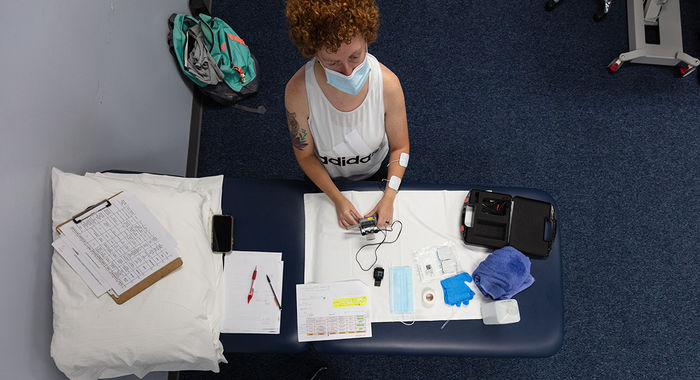
Asked why they chose the Hazleton program, current students cite its reputation for excellence among people in the field, its accreditation, its acceptance of credits they’d already earned at other institutions, the tough curriculum, and the practical aspects of its labs and internships. Some also say that a personal injury they (or a relative) suffered was the motivation for getting into physical therapy themselves.
Bailey Leslie, an adult learner with a BA degree from Temple in kinesiology, signed up for the program at Hazleton at the urging of a physical therapist at a clinic she was working at. “The professors are super nice and helpful, and it’s a smaller program, so you get a lot of attention,” said Leslie, who commutes from Easton to take part in classes and labs.
As a “hands-on learner,” Leslie likes that the labs for each course allow her to practice the concepts she’s learned about in classroom lectures. “The professors do a good job of making sure you get to practice everything,” she said, ranging from exercise and training to use of equipment.
Garrett Rokosky, a first-year student from Selinsgrove, recalled how a grandparent’s rehab process got him interested in the field. “My grandfather had a knee replacement, and I watched how physical therapists and physical therapist assistants helped him get that mobility back,” he said. “That drew me towards wanting to help people come back from their injuries or various disorders.”
Rokosky said that the biggest challenge for him “is the vocabulary that comes with certain muscles and disorders that go along with the muscles.” But he notes that the complicated terminology “helps us plan exercise programs for the patient, how to strengthen them and prevent further injuries.”
Once they complete the program, students have several options available. They can go on and get a four-year degree at Penn State Hazleton, at any other Penn State location, or at another university or college. Another option is provided through an articulation agreement with Misericordia University, which allows PTA program graduates to transfer credits to Misericordia’s DPT program.
Program faculty, besides Petrilla, includes two other full-time teaching professors, two part-time lab assistants, and a full-time lab supervisor. In the classrooms and labs, students learn and perform physical activities utilizing proper body mechanics and techniques, learn the safe and appropriate use of equipment, and are taught how to communicate effectively, using professional terminology both verbally and in writing.
Three full-time clinical off-campus experiences are included in the curriculum. The first occurs in the fall semester of the second year, and the last two experiences occur in the summer after classes and labs have been completed.
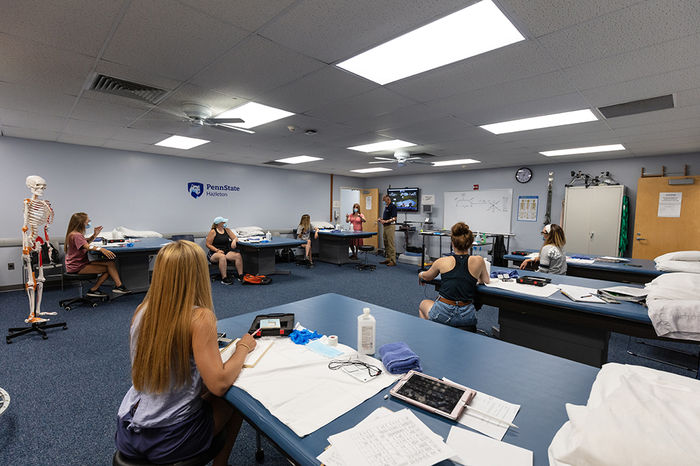
The COVID-19 pandemic provided challenges to the program, especially in the labs. But the program was able to handle the challenges by enhancing sanitation procedures for tables and equipment, using Zoom videoconferencing for certain classes, providing personal protective equipment, partnering students with only one other student (rather than multiple students), using additional classroom space to ensure safe distancing, and so on.
Petrilla said that CAPTE, the accrediting body, would have allowed the program to make allowances for the pandemic by reducing its 600 clinical hours to 440 hours. But the program didn’t take the easy way out, Petrilla said.
“We pushed for our students to get as close as possible to the full clinical experience hours — their only opportunity to treat patients under the supervision of a clinical instructor,” Petrilla added. “That was extremely challenging. It was a commitment to excellence that I am certainly very proud of, and I think it’s going to show [good results] down the line.”
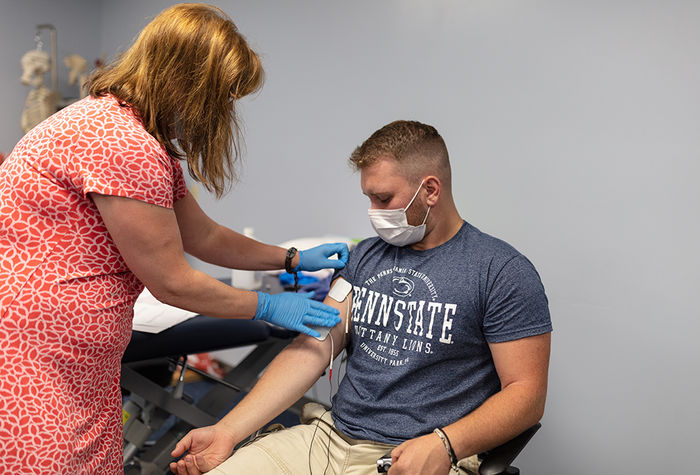
Prebich, the program graduate who’s now VP of operations at Remedy Therapy Services, credits his family and their focus on the healthcare and civic fields — plus some physical therapy he went through after getting injured while playing sports in high school — for sparking his desire to help people.
“I had been a 5’7” power forward and went on to being a shooting guard,” Prebich recalls. “I didn’t want somebody to stuff me, and I ended up herniating a disk in my back. I went into therapy, they rehabbed me and got me back into shape.”
Another hands-on learner, Prebich didn’t actually enjoy all the theory he had to learn in his classes at Hazleton: “It’s a lot to retain. It’s definitely a lot.” But he thinks that the program instructors “did a good job at making it relatable” and he loved the practical skills he learned in the labs and clinical rotations.
“The clinical setup was there,” he said “I feel that I was knowledgeable about the field when I entered it. I knew what to expect.”
Prebich made a point of emphasizing the huge impact that program coordinator Rose Petrilla has made over the years on the program and its students. “One thing I would like to do is give kudos to Rose,” he said. “She definitely lights the fire within and gets you interested.”
